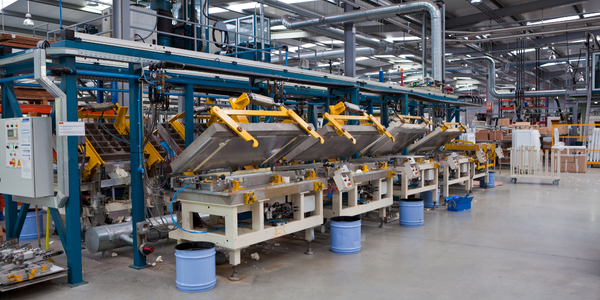
Technology Category
- Infrastructure as a Service (IaaS) - Backup & Recovery
- Infrastructure as a Service (IaaS) - Cloud Computing
Applicable Functions
- Human Resources
- Maintenance
Use Cases
- Personnel Tracking & Monitoring
- Time Sensitive Networking
Services
- System Integration
About The Customer
Eastridge Workforce Solutions is a leading provider of workforce management services and technologies to more than 1,300 clients across North America. The company's time and attendance system processes transactions from thousands of people around the clock, every day of the year. This system verifies who is allowed to be at the workplace and who should be there, and it also records employees' time to generate accurate payrolls. The company's primary objective is to deliver powerful, innovative workforce solutions, and it relies heavily on its IT group to advance these business objectives.
The Challenge
Eastridge Workforce Solutions, a provider of workforce management services and technologies to over 1,300 clients across North America, faced a critical challenge with its time and attendance system. This system, which processes transactions from thousands of people 24/7, 365 days a year, verifies employee attendance and records their time to generate accurate payrolls. Any downtime in this system would be catastrophic, causing significant disruption to Eastridge and its clients. The company needed a high availability/disaster recovery (HA/DR) solution that would ensure the system and its associated data would always be available, regardless of any potential disasters or scheduled maintenance. However, HA/DR was not a core competency for Eastridge, and the company did not want to distract its IT group from its primary business objectives.
The Solution
Eastridge Workforce Solutions turned to Assure MIMIX HA to ensure the constant availability of its IBM i-based time and attendance system and prevent any data loss. Assure MIMIX HA replicates all production data, system data, and applications from the production server to a recovery server. If the production server goes down or needs to be taken offline for maintenance, users can be quickly switched to the backup server, ensuring continuous availability of the application and its data. Eastridge also employed Precisely Managed Services to monitor, manage, and maintain its HA/DR solution. This service monitors the Assure MIMIX replication processes around the clock, ensuring they are always running properly and efficiently. If an issue arises, Precisely experts can often quickly resolve it remotely. This solution also protects against downtime during scheduled maintenance, with Managed Services undertaking all the work.
Operational Impact
Quantitative Benefit

Case Study missing?
Start adding your own!
Register with your work email and create a new case study profile for your business.
Related Case Studies.

Case Study
Goldcorp: Internet of Things Enables the Mine of the Future
Goldcorp is committed to responsible mining practices and maintaining maximum safety for its workers. At the same time, the firm is constantly exploring ways to improve the efficiency of its operations, extend the life of its assets, and control costs. Goldcorp needed technology that can maximize production efficiency by tracking all mining operations, keep employees safe with remote operations and monitoring of hazardous work areas and control production costs through better asset and site management.

Case Study
Cisco Kinetic for Oil and Gas: Refineries and Plants
The plant manager and safety teams needed a solution that provided near real-time visibility of gas detection and personnel location, with easy to understand visualization and alerting dashboards. This would enable them to improve productivity through decreasing the time taken to start work, optimize evacuation route planning, and to meet critical staff safety and compliance goals.

Case Study
Digital Transformation of Atlanta Grout & Tile: An IoT Case Study
Atlanta Grout & Tile, a Tile, Stone & Grout restoration company based in Woodstock, Georgia, was facing challenges with its traditional business model. Despite steady growth over the years, the company was falling behind the web revolution and missing out on the opportunity to tap into a new consumer base. They were using independent software from different vendors for each of their department information and workforce management. This resulted in a lot of manual work on excel and the need to export/import data between different systems. This not only increased overhead costs but also slowed down their response to clients. The company also had to prepare numerous reports manually and lacked access to customer trends for effective business decision-making.

Case Study
Industry 4.0 at ALPLA: Enhancing Factory Efficiency with IoT
ALPLA, a global leader in packaging solutions, faced several challenges as the complexity of their production machinery increased. The need for highly trained specialists in each factory led to higher personnel costs, difficulties in recruiting experienced talent at each location, and costly personnel turnover. Furthermore, less experienced operators running the machines sub-optimally impacted resource consumption and overall equipment effectiveness (OEE). ALPLA also faced the challenge of monitoring visual inspection systems in every line of their plants, which was almost impossible to do manually. In 2016, ALPLA decided to use data from the 900 different types of embedded sensors in each factory to address these issues. However, their initial choice of SQL Server as the data store for the sensor data proved inadequate, as it was unable to cope with their data requirements.

Case Study
Centralizing Data for Improved Efficiency: A Case Study on Malvern Panalytical
Malvern Panalytical, a UK-based hi-tech electronics company, was grappling with the challenge of decentralized data storage. The company had a vast amount of unstructured data scattered across various platforms, from hard drives to emails and floppy disks. This made the data searching process extremely cumbersome and inefficient. The company's rapid growth, from 200 to over 1,000 employees in a decade, and expansion across three continents further exacerbated the need for a more structured and centralized data system. As a company involved in electronics manufacturing and software development, it was crucial for Malvern Panalytical to find a platform that could structure all their data, track all modifications of documents in real time, and provide clear visibility of the internal information flow across all its facilities.




